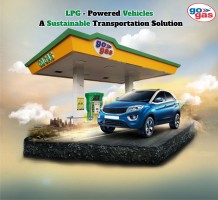Blog Details
LPG Safety: Dispelling Myths and Understanding Precautions
Liquified Petroleum Gas (LPG) is a versatile and
clean-burning fuel used in various applications, from heating and cooking to
powering vehicles. While LPG offers numerous benefits, some misconceptions and
concerns about its safety persist. Liquefied Petroleum Gas (LPG) serves as a
convenient and efficient energy source for countless households and businesses
worldwide. In this blog post, we aim to dispel myths surrounding LPG and
provide a clear understanding of the precautions necessary to use LPG safely.
Understanding
LPG:
LPG, a versatile fuel, comprises a combination of
propane and butane gases, stored under pressure as a liquid. Its usage spans
cooking, heating, and powering various appliances. Despite its widespread use,
apprehensions often arise due to misconceptions about its safety.
Dispelling
Common Myths:
Myth
1: LPG is Highly Explosive
One of the most common misconceptions about LPG is
that it is highly explosive. While LPG can be dangerous if mishandled, it is
not inherently explosive. LPG only becomes hazardous when it is mixed with air
in specific proportions and ignited. Proper storage and handling can greatly
reduce the risk of such accidents.
Myth
2: LPG Causes Health Issues
When burned efficiently, LPG emits minimal pollutants,
making it a cleaner fuel compared to others. However, incomplete combustion due
to faulty appliances can release harmful substances like carbon monoxide.
Regular maintenance and proper ventilation are essential to prevent health
risks.
Myth
3: LPG Can Leak Through Walls
Another myth is that LPG can leak through walls and
into homes, posing a constant threat to safety. In reality, LPG is stored in
tanks or cylinders designed to withstand pressure and prevent leaks. Properly
installed and maintained LPG systems should not leak into the surrounding
environment.
Myth
4: LPG is Heavier than Air and Collects in Basements
Contrary to popular belief, LPG is lighter than air.
In the event of a leak, it will disperse into the atmosphere rather than
sinking and accumulating in basements or low-lying areas. This property reduces
the risk of explosions in confined spaces.
Myth
5: LPG Cylinders Are Dangerous
LPG cylinders, when handled and maintained correctly,
are not inherently dangerous. They are manufactured to stringent safety
standards and undergo regular inspections. Users must ensure proper handling,
storage, and maintenance to prevent accidents.
Understanding
LPG Safety Precautions
Now that we've dispelled some common myths, let's
delve into the essential precautions for safe LPG usage:
1.
Proper Installation and Maintenance
For any LPG system, whether in a home or a vehicle,
professional installation and regular maintenance are crucial. Certified
technicians should handle installations, ensuring that all connections and
fittings are secure and leak-free. Regular inspections and maintenance checks
can detect and address potential issues before they become safety hazards.
2.
Use Approved LPG Containers
Always use approved LPG containers, such as cylinders
or tanks, which adhere to safety standards. Avoid using damaged or expired
containers, as they can pose safety risks. Check for certification labels to
ensure the container's integrity.
3.
Store LPG Containers Safely
Store LPG containers in well-ventilated areas away
from direct sunlight, heat sources, and flammable materials. Containers should
be kept upright and secured to prevent tipping. Ensure that storage areas are
dry and free from water accumulation.
4.
Handle LPG with Care
When connecting or disconnecting LPG containers, exercise caution. Avoid damaging valves or fittings, and use appropriate wrenches and tools. Do not drop or mishandle containers, as this can cause damage and potential leaks.
5.
Check for Leaks
Regularly inspect LPG systems for leaks. A simple soap
and water solution applied to connections and valves can reveal leaks through
the formation of bubbles. If a leak is detected, turn off the gas supply
immediately and consult a professional for repairs.
6.
Ventilation
Proper ventilation is essential when using LPG indoors.
Ensure adequate airflow to prevent the buildup of gas in enclosed spaces. Use
LPG appliances only in well-ventilated areas and follow manufacturer
recommendations for safe usage.
7.
Install Gas Detectors
Consider installing LPG gas detectors in your home or
facility. These devices can provide early warnings of gas leaks, allowing you
to take immediate action to prevent accidents.
8.
Educate Yourself and Others
Familiarize yourself and your family or colleagues
with LPG safety guidelines. Ensure that everyone knows how to shut off the gas
supply in case of an emergency. Conduct periodic safety drills to reinforce
proper procedures.
Conclusion
LPG is a safe and efficient energy source when handled
correctly. Dispelling myths and understanding safety precautions are vital
steps towards ensuring a secure environment. LPG can continue to be a valuable
part of our energy landscape, contributing to a cleaner and more sustainable
future when used responsibly. By adopting preventive measures, conducting
regular maintenance, and staying informed about LPG safety guidelines, users
can confidently enjoy the benefits of this versatile fuel while prioritizing
safety for themselves and their surroundings. Always remember, that precaution
is key to utilizing LPG safely and responsibly.
Latest Blogs
Suggested Blogs

How Liquefied Petroleum Gas (LPG) Transforms Commercial and Industrial Business Success
Read More
LPG-Powered Vehicles: A Sustainable Transportation Solution
Read More
LPG for Rural Development: Empowering Communities with Clean Energy
Read More
